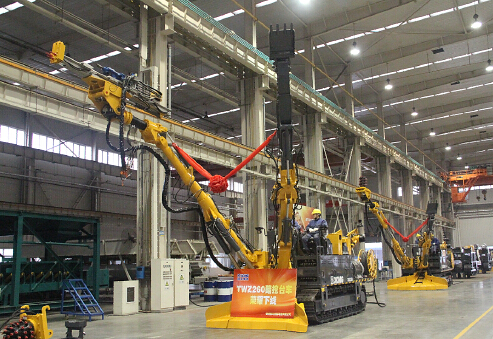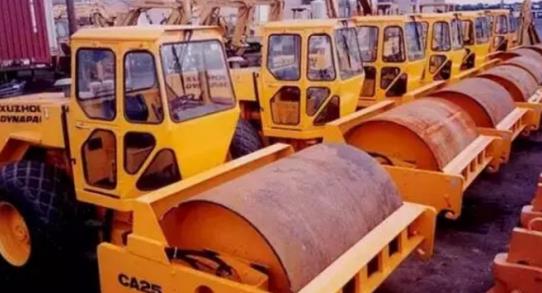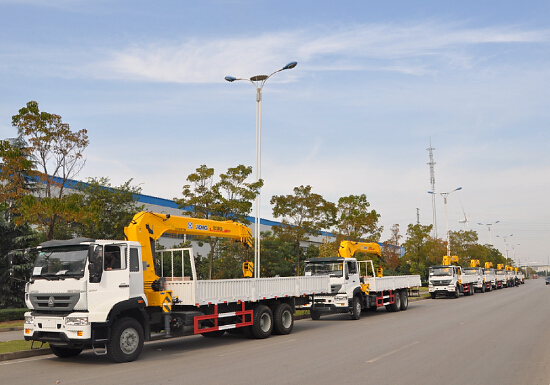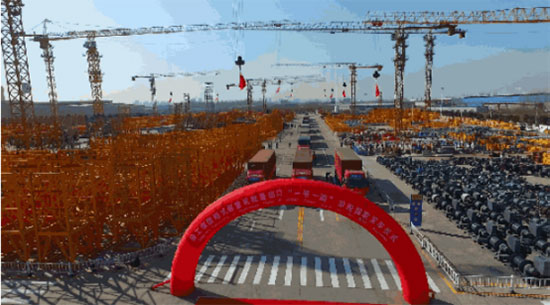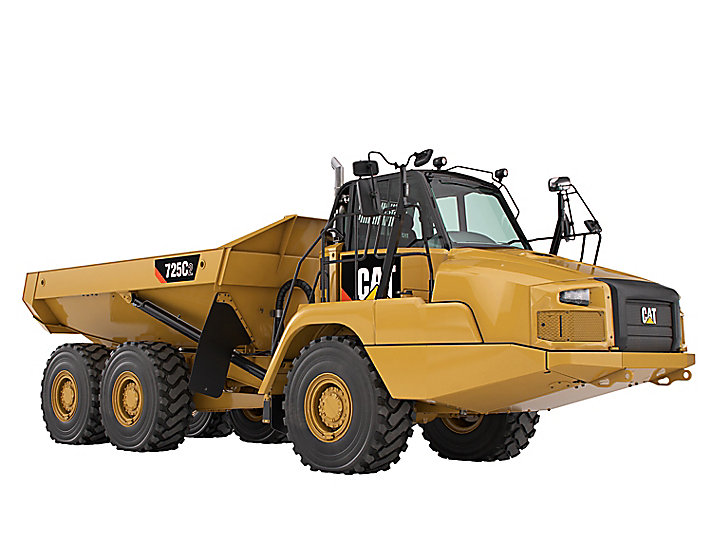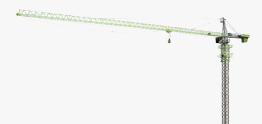Contact information:
Erwann Maillot
Marketing Communication
Tel.: +33 609 243 709
E-mail: Erwann.Maillot@terex.com
terex® ctl 430-24 carries the load during library reconstruction
Luffing jib tower crane the right fit for Smith Bros. & Wilson for challenging downtown project
ZWEIBRÜCKEN, Germany – December 6, 2017 – New construction projects always come with a set of challenges, but the site and lifting needs are usually straight forward enough that several different crane options fit the requirements. Building reconstruction, on the other hand, typically comes with its own unique challenges. Often, there are obstacles in the way that make selecting the right crane much more difficult, and bidding the right crane can be the difference between getting the job and moving on to the next opportunity.
Major metropolitan downtown reconstruction projects offer even more challenges for the lifting contractor. It is a virtual certainty that the site will be surrounded by structures on all sides, making it a tight fit for mobile cranes. Busy streets make it nearly impossible and sometimes cost-prohibitive to block off a road for a significant period of time.
This is precisely the type of demanding project facing contractor, Smith Bros. & Wilson (BC) Ltd. (SBW) of Vancouver, during the demolition and reconstruction of the 8th and 9th floors at the downtown Vancouver Public Library (VPL). The tasks included converting the once Provincial government office spaces into additional library space, meeting rooms and an urban green space, all while keeping the library open to thousands of visitors daily.
Demolition and construction activities required many materials, large and small, to be moved. “All the demo material had to be removed,” explains Tyler Brown, general superintendent for SBW, “and the library only had service elevators to get material from the top floors to street level. During the tender phase, we saw the need to hoist many items, including large-span escalators to get people up to the green space. It was quite a challenging prospect.”
Terex Tower Crane the Right Solution
VPL is a very high profile project for the city, as the building’s distinct design makes the library a focal point of the downtown area. While the historical look allows it to stand out, it also poses unique challenges that require much preplanning in order to properly bid.
“The library is designed after the Roman Colosseum and surrounded by an elliptical wall on the east side,” comments Dean Arsene, crane rental & sales representative for Leavitt Machinery of Vancouver, an authorized Terex Cranes distributor. “We started discussing the project with SBW in late 2016, and all options were reviewed.”
Like most contractors submitting bids, SBW initially considered mobile cranes to tackle the heavy lifting from street level. Unlike those companies, however, SBW saw several drawbacks that made planners rethink the option.
“The structure’s shape required a minimum of a 500-tonne (600-ton) capacity class mobile crane to hoist large materials to and from the upper floors because it would be boom bound,” says Brown. Given the possible set-up locations for a mobile crane at the site, smaller cranes just did not offer capacity to lift many of the objects at the required boom lengths and working radii. “This meant we would have had to shut down an entire street, and mobilization costs would have been high. By the time we counted everything that needed to be hoisted, it was cost-prohibitive to use a mobile crane.”
The next option for SBW was tower cranes, and they looked at flat top, hammerhead and luffing jib designs. “The job required a 180.4-ft (55-m) boom radius, and the flat top and hammerhead cranes didn’t offer the capacity we needed for the escalators without breaking them down,” mentions Brown. Plus, there was a more pressing issue, as the crane would be placed about 50 ft (15.2 m) from an adjacent structure. “Those booms were too long, and they didn’t have the freedom to slew without hitting a structure, so these designs were not an option,” explains Arsene.
For SBW, the only option to cost-efficiently support demolition and construction efforts on the VPL project was a luffing jib tower crane, and the Terex® CTL 430-24 offered the reach and capacity for the job. “Through our discussions with Leavitt, we calculated the luffing jib as the most economical hoisting logistics solution for us,” offers Brown.
Steve Filipov, president of Terex Cranes, mentions the company offers a complete line of tower cranes as part of its lifting solutions because of challenging projects like this. “The VPL application is one of those unique cases where the mobile cranes we manufacture aren’t the most economical solution for our customers,” he says. “As the industry’s innovative lifting equipment solutions provider, we are committed to the tower cranes business, so we can partner with our customers for all their lifting needs.”
CTL 430-24 Rising
Bidding the job using the CTL 430-24 crane helped SBW receive the contract. For the year-long renovation project, SBW entered into a six-month rental agreement with Leavitt for the 26.5-ton (24-tonne) class Terex luffing jib tower crane. Its tower required seven HD23 22.6 segments to reach the needed jib base height of 147.6 ft (45.0 m).
To cover the entire site, the CTL 430-24 was equipped with a 180.4-ft (55-m) jib. A 15-degree in-service radius was used throughout the project to lift materials to and from the rooftop. “Using the luffing jib allowed us to position the tower closer to the library structure, but, even still, most of our lifts were made close to tip radius of the 180.4-ft (55-m) jib,” says Brown. Arsene adds, “When the crane was not in service, the jib was set to a 65-degree radius to allow it to slew without hitting any of the adjacent structures.”
Meticulous planning led to flawless execution of crane installation the weekend of June 10 for Leavitt and SBW. The city allowed the adjacent Homer Street to be closed to facilitate installation. “Using a 300-tonne (350-ton) capacity mobile crane, we installed the tower, counter jib and apex on day one,” recalls Arsene. “On day two, we installed the jib and counterweight. It was a very smooth set-up, and we were done in about 1.5 days.”
Throughout the demolition phase, the crane was kept busy daily removing large structural pieces and concrete from the rooftop. Choosing the tower crane for this project gave work crews more flexibility with material removal.
As work transitions to the reconstruction phase, the crane will be used to hoist large building materials and full concrete buckets from street level to the 8th and 9th floors. The largest and heaviest planned lifts will be the two, 12,000-lb (5.4-tonne) escalators, hoisted into position without disassembly to save time and money.
“The plan calls for the escalators to be placed toward the end of the 180.4-ft (55-m) jib, and the crane’s load chart offers plenty of capacity to position the two pieces,” says Arsene. Brown adds, “The type of crane we are using is proving to be key for our success, and the CTL 430-24 is working great for us and doing its job.”
If all continues to go according to plan, SBW will stop using the Terex luffing jib tower crane at the end of 2017. “We’ll finish all the heavy lifting by December, and then we’ll have the smaller finishing stuff throughout the end of contract.”
Ingenious Concrete Base Solution
To further reduce project costs, SBW’s plan for the CTL 430-24 crane included a freestanding tower that wasn’t tied into the library’s structure. Originally, SBW planned on using an undercarriage strut mounting for the tower section. However, the optional base’s availability was limited and not available in western Canada.
SBW put its century-plus concrete fabrication experience to work and consulted with engineering firm, TNAI Engineering Ltd. of Vancouver, to construct a custom concrete base to serve as a tying point for the crane’s tower. TNAI came up with an ingenious way to anchor the crane in a manner that would not require it to be secured directly into the building’s foundation.
Anchoring to the foundation would require cutting through the street-level membrane and closing the three-level underground parking structure. “You don’t know what type of utilities and electrical components you will run into when cutting into the membrane, and this could lead to significant expense and delays,” explains Arsene.
TNAI’s engineering team came up with a “floating” 32.8- x 32.8 ft (10 x 10 m), X-shaped concrete base. “When reviewing the parking lot’s drawings, we found columns supporting the library’s parking structure that were built at a 32.8- x 32.8-ft (10- by 10-m) spacing, so we tied directly into those columns,” adds Arsene. The columns served as the anchor conduit to the foundation below the parking structure.
The concrete anchor measured 6-ft (1.8-m) wide, and height along most of the cross section was 6.5-ft (2.0-m) tall. The outside 4-ft (1.2-m) end segments of the structure anchoring into the columns were 8.5-ft (2.6-m) tall. “This, in essence, gave us 2-ft (0.61-m) spacing between the concrete end segments and grade at the center of the X-shape to create the floating base required to properly disperse the load,” explains Arsene.
By employing the ingenious solution, SBW saved time, lowered costs and allowed the parking structure to remain open during the year-long reconstruction project. “It was a pleasure working with SBW on this project,” concludes Arsene. “They have the expertise to find the solutions to successfully complete a challenging project like VPL, and they don’t shy away from them.”
About Smith Bros. & Wilson
Smith Bros. & Wilson (SBW) has continuously played an important role developing western Canada since 1897. Continuing today, SWB has earned a reputation for reliability that is second to none. From seismic upgrades and renovations to breweries, hospitals, educational facilities, pulp mills and office towers, the SBW logo is found on construction sites as diverse and challenging as the industry offers. SBW also maintains a highly skilled workforce to perform all concrete forming, placing and finishing work.
For more about SBW follow this link: http://smithbroswilson.com/.
About Leavitt Cranes
With over 25 locations to service western Canada and the Pacific Northwest, Leavitt Cranes is a dedicated crane company providing flat top, hammerhead and luffing jib tower cranes, self-erect and mini crawler crane sales, rentals, service, parts and training. Offering industry leading brands, Leavitt provides only the best in crane solutions.
For more about Leavitt Cranes follow this link: http://www.leavittcranes.com/.
About Terex
Terex Corporation is a global manufacturer of lifting and material processing products and services delivering lifecycle solutions that maximize customer return on investment. Major Terex brands include Terex, Genie, Powerscreen and Demag. Terex solutions serve a broad range of industries, including construction, infrastructure, manufacturing, shipping, transportation, refining, energy, utilities, quarrying and mining. Terex offers financial products and services to assist in the acquisition of Terex equipment through Terex Financial Services. More information about Terex is available on its website: www.Terex.com, and on its LinkedIn page -- www.linkedin.com/company/terex and Facebook page -- www.facebook.com/TerexCorporation.



